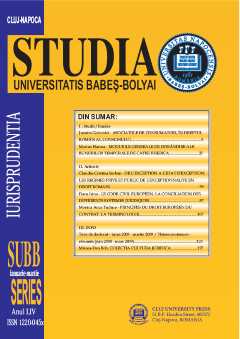SPUREN DER RECHTSGESCHICHTE IN MOZARTS DA PONTE-OPERN
TRACES OF LAW HISTORY IN MOZART'S DA PONTE OPERA
Author(s): Reinhard MussgnugSubject(s): Law, Constitution, Jurisprudence
Published by: Studia Universitatis Babes-Bolyai
Summary/Abstract: Traces of law history in Mozart's da Ponte opera. Whoever intends to discover legal aspects in Mozart's da-Ponte operas, shouldn't attack them with the same questions, with which the district court judge from Gifhorn/Lueneburg Ernst von Pidde tried to cope with Richard Wagner's "Ring" in his treatise from 1968 "Richard Wagner's 'The Ring of the Nibelung' in the Light of German Penal Law". Piddes analysis without doubt distinguishes itself by a certain entertainment value for which the lawyers among the German Wagnerians hold it in high regard. Nevertheless its benefit for jurisprudence tends towards zero, and it entertains just mediocrely to discuss - whether Don Giovanni has committed murder in the sense of sec. 211 or just manslaughter in the sense of sec. 212 of the German Penal Code with the killing of Donna Anna's father at the beginning of the opera to which he has given his name, - if the maid Despina should have been punished for unlawful assumption of authority according to sec. 132 PC for feigning the notary in the finale of "Cosi fan tutte"; - or if Count Almaviva and his county judge Don Curzio are guilty of perversion of justice in the sense of sec. 339 PC for sentencing Figaro to marry Marzellina in the third act of "The Marriage of Figaro". The search for the traces the legal zeitgeist of the late 18th century has left within the three librettos Lorenzo da Ponte has written for Wolfgang Amadeus Mozart promises far more yield for jurisprudence and its history. "Cosi fan tutte" provides at least the topics for a remark about the history of matrimonial law. In "Don Giovanni" distinctly more then just the material for a legal footnote is to be found. "The Marriage of Figaro" in the end can't be understood correctly without some knowledge of legal history; this opera after all deals in it's first three acts with the law suite "Figaro versus Marzellina for marriage or payment", which, as it's mis- and none-understandings by the contemporary opera directors proof, urgently needs some legal and historic explanations.
Journal: Studia Universitatis Babes Bolyai - Iurisprudentia
- Issue Year: 52/2007
- Issue No: 1
- Page Range: 5-22
- Page Count: 18
- Language: German

